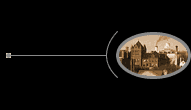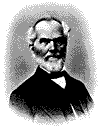


 |
  |
|
| The chancellor arrives. |
Dr. Lathrop, having accepted the chancellorship, arrived at Madison in October, 1849. When the regents held their third meeting, the twenty-first of November, he formally appeared before the board, to assume the ex officio presidency thereof. He was welcomed by Regent Eleazer Root, president pro tem., in the following words, as we learn from the well-kept minutes in the bold handwriting of Regent Julius T. Clark, the secretary:
The chancellor; being conducted to the chair, thus responded:
|
 JOHN H. LATHROP |
| Lathrop's inauguration |
These were brave and hopeful words; and the brief newspaper comments of the day--educational news, however, paled before political reports, in early Wisconsin--indicate that the public temper, so far as it concerned itself at all with the University, was in a similarly optimistic mood. Yet affairs moved with exceeding deliberateness. It was the sixteenth of January (1850) before the chancellor was inaugurated, and thus actually entered upon his duties and the enjoyment of his meagre salary. The University had been organized at the meeting of the regents in January of the preceding year, and its anniversaries are reckoned therefrom; but the institution was not avowedly opened until this ceremony of inauguration, which took place in the assembly chamber at the capitol, the chancellor delivering an address, and Regent A. Hyatt Smith, of Janesville, speaking in behalf of the regents. Like the University, the Wisconsin press was still in its infancy. There were no daily papers in Madison--and the Milwaukee Daily Sentinel, but five years old, had no correspondent on the grounds. It was the twenty-second of the month before a report of the proceedings appeared in the Madison Express, and then only briefly, as follows:
|
|
| Preparatory department. |
It was a stretch of reportorial fancy--that is as old as journalism itself--to say that "students of the University were of the audience. There were as yet no students. It was the fifth of February before Professor Sterling opened the preparatory school on the lower floor of the Female Academy building,--on the site of the present Madison high school,--having twenty pupils upon his roll.1 Most of these were from the village of Madison, "owing in great part," says Professor Sterling in his first report, "to the difficulty of obtaining board at Madison, upon sufficiently moderate terms, especially during the session of the legislature." On the twenty-second of February, the legislature, by joint resolution, confirmed the action of the board in all particulars, and the University was at last fairly launched. |
|
| Addition to the grounds. |
In their second annual report, presented by the regents to the legislature upon the day of Chancellor Lathrop's inauguration, they state that to the tract purchased of Vanderpool they made a few additions. From the land acquired, they have had a portion "surveyed and laid out in streets and town lots," hoping therefrom to acquire sufficient money to purchase the entire tract.2 The University site itself, they describe as comprising "fifty acres, bounded north by Fourth lake, east by a street to be opened at right angles with King [later State] street, south by Mineral Point Road [University avenue], and west by a carriage-way from said road to the lake." They further report that on the fifteenth of January they had adopted the following plan for buildings and other improvements upon the campus:
Inasmuch as the income thus far received from the University lands is insufficient for building: even the two dormitories which it is recommended shall at once be erected,--leaving the main building "for a year or two, and the residue for several years,"--the board ask the legislature for a loan of $25,000, pledging the University income to its repayment. Governor Dewey having favored the plan in his message, the legislature made the loan as requested--it should have been a direct appropriation. In giving Wisconsin the endowment for a University, the undoubted intent of Congress was, that the income should be used for support, not for buildings and equipments; these the State itself ought to have furnished. Wisconsin not only shamefully mismanaged the trust, but, after reducing the income to a bagatelle, obliged the University to erect its own buildings from that income. This policy, inaugurated in 1850, was of questionable legality, and fraught with serious consequences to the institution. |
|
| North dormitory built. |
The building thus provided for was the North Dormitory, which cost $19,000, and was opened to the use of the preparatory school and the two first collegiate classes (freshman and sophomore),3 September 17, 1851. "Besides the public rooms for lecture, recitation, library, cabinet, apparatus, &c.," reports the chancellor to the board, on Christmas day of that year, "it will accommodate from fifty to sixty-five students, with apartments for study and lodging. * * * Most of the students prepare their lessons in their respective rooms, and are called together, by classes, at the proper hour for recitation. All the rooms are daily visited by the Faculty, and a strict responsibility maintained as to their use. The younger scholars, however, do not reside in the building, but attend the day exercises, and study in the presence of their instructors, in the public rooms." Later, a "mess hall" was established within the building, "to obviate still farther any objection to membership in the University arising from the cost of residence in Madison * * * and it is believed that the expenses of the table need not exceed eighty cents per week to each member of the association." From the report of the building committee of the board, we learn that "the fourth story is distributed into six public rooms for the purposes of lecture, recitation, library, cabinet, &c. The three lower stories contain twenty-four studies, with two or three bed-rooms and a closet attached to each, adapted to the convenience of the pupils while resident members of the institution;" also that the building is heated by two hot-air furnaces in the basement. |
 OLD NORTH HALL |
| Early discouragements. |
The regents were just now optimistic, their reports taking a roseate view of the future; yet, up to the close of this year (1851), the sales from the University lands had amounted to but $25,000; and a loan equal to this principal had been secured from the legislature, for building purposes. Thus, the income of the fund, which should have been devoted solely to the payment of salaries and the purchase of books and apparatus--and would have been had the legislature not shamefully sacrificed the University lands to attract population, and in so doing violated its faith with the national government--had now largely to be applied to repayment of the loan. The outlook was far from encouraging. The University was, for the most part, still on paper, and already badly in debt, with its patrimony wasted. Nominally, there were several departments--in reality, a preparatory school and two small collegiate classes in but one department. On paper, there were six professorships: (1) ethics, civil polity, and political economy; (2) mental philosophy, logic, rhetoric, and English; (3) ancient languages and literature; (4) modern languages and literature; (5) mathematics, natural philosophy, and astronomy; (6) chemistry and natural history. As a matter of fact, but two chairs were occupied--the chancellor taking No. 1, and Professor Sterling No. 5, with O. M. Conover4 as general tutor. In the third year (commencing September, 1852), Mr. Conover took chair No. 3, and was succeeded as tutor by Stephen H. Carpenter.5 |
|
| The first graduates. |
Such was the composition of the Faculty when, in 1854, the first class graduated, consisting of Levi Booth and Charles T. Wakeley. Natural science was not taught until May, 1854, when S. P. Lathrop, formerly of Beloit College, became professor of chemistry and natural history; he died in December following, the chair remaining vacant for a year, when E. S. Carr6 was chosen his successor. At the opening of the collegiate year of 1855-56, Daniel Read7 was elected professor of mental philosophy, logic, rhetoric, and English literature; and John P. Fuchs,8 who had been a tutor in the institution, was advanced to the professorship of modern languages and literature. Thus, at last, all the chairs were filled; but as yet, the maximum salary for a professor in the University was only a thousand dollars. |
|
| South dormitory built. |
We have seen that the establishment of a normal department for the training of teachers was one of the earliest ambitions of the board, and in their reports to the legislature they annually returned to the charge. Lack of funds, however, prevented an immediate accomplishment of this purpose. The projected South Dormitory was intended to be the home of this department. For the purpose, another advance was secured from the legislature, this time of $15,000; and the structure was ready for occupancy in the autumn of 1855. The regents' report (dated January 1, 1856) says: "The south half of the building contains public rooms for lecture, for library, and for collections in natural science, apartments for some of the families of the faculty, and a dining hall for the common use of the faculty and the students. The north wing (sic) contains studies and lodging rooms for the use of the students, and the whole is warmed in winter by furnaces in the basement, "It appears that the students paid $1.72 per week for board at this dining hall, being the actual cost; while each member of the families of the resident faculty paid $3."9 The building had cost the University $20,000, thus still further crippling the income of the institution, and forcing the regents, as they confess, to abstain from purchasing books and apparatus, or fully carrying out their scheme for normal training. However, in May, 1856, Professor Read, in addition to his other duties, was elected to the chair of the theory and practice of elementary instruction, and delivered a course of lectures, giving another course in the succeeding autumn. There the matter was for the time dropped; it was not until 1863 that the normal department was actually opened. |
 OLD SOUTH HALL |
1 These were: Levi Booth, Byron E. Bushnell, Charles Fairchild, William H. Holt, Daniel G. Jewett, Charles D. Knapp, Francis Ogden, Robert Ream, Robert D. Rood, Charles B. Smith, Hayden K. Smith, George W. Stoner, Richard F. Wilson, and Albert U. Wyman, of Madison; James M. Plower, of Sun Prairie; Henry McKee and Stewart McKee, of Platteville; Charles T. Wakeley, of Whitewater; William A. Locke, of Lake Mills; and William Stewart, of Ancaster, Canada West. During the second term, there were 27; among the newcomers being Horace Rublee, of Sheboygan.
The school year was divided into two terms of twenty weeks each. The instructional force consisted of Professor Sterling, who took the chair of mathematics, natural philosophy, and astronomy; and the chancellor, who assumed the chair of ethics. When the first University class was formed (August, 1850), the chancellor and Professor Sterling were still the sole teaching force; but in the second term, they secured O. M. Conover as tutor.
2 All the land not included in the fifty acres set aside as the college site, was laid out into 174 village lots and 12 five-acre or out lots, a part of which" was recorded as the "University addition to the Village Plot of Madison." Nearly all of these parcels of land had been sold before 1856. The money thus obtained was for several years the chief income of the board.
3 A freshman class had been formed August 4, 1850, and its members were now the sophomores.
4 Obadiah Milton Conover was born in Dayton, Ohio, October 8, 1825, of parents descended from Dutch stock. Like Sterling, he graduated from Princeton (class of 1841), afterwards teaching Latin and Greek near Lexington, Ky., and in Dayton, and studying law at the latter place. In 1849, he was graduated from Princeton theological seminary, but rarely occupied a pulpit. Coming to Madison in 1849, he was at first editor of a literary and educational monthly, The North-Western Journal; and in 1850 was appointed instructor in ancient languages in the State University--being thus the third member of its faculty, in order of appointment. Elected in 1852 professor of ancient languages and literature, he filled the position until 1858, when he passed out with his colleagues, in the revolution of that year. He was a member of the board of regents, 1859-65, then went abroad to collect books, pictures, and busts for the University. Admitted to the bar in 1859, he became, two years later, reporter of the State supreme court, retaining the position until his death (in London) in 1884. He was twice married--in 1849 to Miss Julia Darst, who died in 1863; and in 1882 to Mrs. Sarah Fairchild Dean, who survives him.
5 Stephen Haskins Carpenter was born in Little Falls, N. Y., August 7, 1831, and fitted at Munro Academy, Elbridge, N. Y. His first two college years were spent at Madison University, Hamilton, N. Y.; but he graduated from the University of Rochester in 1850, coming at once to Wisconsin. Joining the faculty of the University of Wisconsin as Professor Conover's successor, he held the position for two years, being succeeded by Augustus L. Smith. For four years, he was at first editor and one of the publishers of the Madison Patriot, and later of the Western Fireside--the latter a venture which failed in January, 1858. The succeeding ten years he spent in various occupations,--teaching, public office, and newspaper work,--but returned to the faculty of U. W. in October, 1868, taking the chair of rhetoric and English literature, as the successor of Professor Read. He died in 1878, leaving a lasting reputation as a teacher and scholar.
6 Ezra S. Carr was born in Stephentown, Rensselaer county, N. Y., March 9, 1819. In 1842 he graduated from Castleton (Vt.) Medical College, with degree of M. D., at once taking the chair of chemistry and natural history in that institution; he was also a lecturer in medical schools in Philadelphia, and at one time served in the Vermont legislature. He had a temporary call to Wisconsin University in 1853, but declined this in favor of a permanent professorship in the University of Albany, N. Y., lecturing also at Middlebury (Vt.) College. Coming to Wisconsin University early in 1856, he served for twelve years as professor of chemistry and natural history, being also a commissioner of the State geological survey, and (1857-59) a member of the board of regents. In 1869 he went to the University of California, being a professor there for six years, and later State superintendent of public instruction. He died at Pasadena, November 28, 1894.
7 Dr. Read was born near Marietta, Ohio, June 24, 1805, and graduated from Ohio University in 1824. He became professor of political economy and constitutional law at his Alma Mater, and attained the position of vice-president. In 1843, he was chosen professor of ancient languages in the Indiana University--in 1850, serving as member of the Indiana constitutional convention. He came from Indiana to accept his chair at Madison, serving until 1868, when he went to Missouri University to succeed Dr. Lathrop as its president. He retired from college life in 1876.
8 John P. Fuchs was born in Paramaribo, Surinam (Dutch Guiana), in 1823, the son of a German from the Rhine valley. In 1831, young Fuchs was placed at school in Holland, later studying at Cologne, Bohn, Heidelberg, and Berlin; he won his degree of M. D. in Germany, at the age of 25, and practiced in the Paris hospitals. Emigrating to America in 1849, he reached Wisconsin in 1854, soon (1855) becoming professor of modern languages and literature. Leaving the University in 1856, he taught in the Milwaukee high school, but returned to the University in 1861, serving till 1868; he then took up the practice of medicine in Chicago, dying there November 16, 1876.
9 In an article in the Badger for 1889, "An Early Decade at the Wisconsin University," Dr. James D. Butler writes entertainingly of his experiences as a professor at the University (1858-68). He says: "The grounds of the establishment, perhaps forty acres, were hemmed in on the west by a line running from the lake through the valley east of Observatory Hill. Its buildings were two, namely, the North Dormitory, dating from 1851, and the South from 1854. In the former were students' rooms, recitation rooms and the chapel. In the South Dormitory, in addition to lecture rooms, and the chemical laboratory, there was the University collection of minerals, as well as of fauna and flora. But this edifice was mainly a boarding house. The center of the lower story was a dining-room. At the head of each table sat a Professor, and most of the out-of-town students depended for their daily bread on these commons. Each professorial family had the use of a flat, or a portion of one. Wood-furnaces made the whole pile comfortable. The caterer was a steward appointed and salaried by the regents, who kept down prices and bore losses.
"But in 1859, finding the losses too great, they obliged the Professors,
whom they had before crowded into the Dormitory, either to leave
it altogether, or to buy in the old furniture, cows, etc., and
furnish board to such students as desired it. Three of us remained;
the rest took houses in town. Two of the three departed at the
close of another year, and so, for a year or two, I was, with
my family, the sole occupant of the huge building, and one of
my children was born there. Nobody claimed board, and I was not
obliged to grant it."